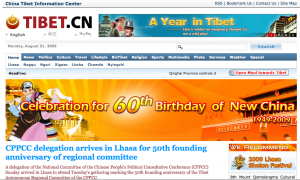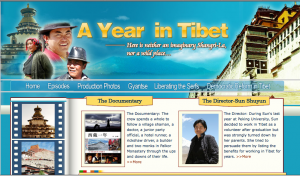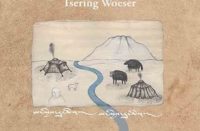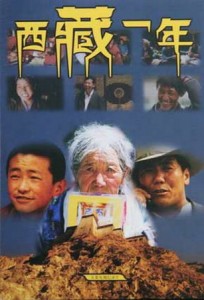High Peaks Pure Earth has translated a blogpost by Woeser originally written for Radio Free Asia on August 12, 2009 and posted on her blog on August 19.


“A Year in Tibet: Not At All Unexpected ‘Foreign Publicity'” by Woeser
Recently, from CCTV to the Nanfang Zhoumo (Southern Weekend newspaper), the Chinese media were full of praise for a documentary titled “A Year in Tibet”. One critique was particularly thought-provoking calling the documentary “unexpected ‘foreign publicity'”. Here, “foreign publicity” refers to propaganda targeted at foreigners and even though it was written in quotation marks, I couldn’t help but immediately think of the Chinese Department for External Propaganda.
As a matter of fact, there are two different versions of this five episodes long documentary: the BBC version and the CCTV version; the associated book also exists in English and in Chinese. I watched the BBC documentary and read the Chinese edition of the book. I noticed two particular points about the documentary: firstly, there is a slight difference between these two versions. It is said that every episode of the CCTV version is 12 minutes shorter than the BBC one and some of the commentary has also been modified. Secondly, although both versions differ from each other, the Chinese media have credited the CCTV version with some of the same comments the BBC version received, for example the remark: “obtained the West’s and the Dalai Lama’s approval”.
Now, what is the main effect of editing out 20% of each episode? And in terms of conveying certain contents, how was the commentary modified? Moreover, can these things really be regarded as insignificant? Judging from my experience and knowledge of living in China, I believe that one should by no means ignore such details. It is just like what the Chinese independent intellectual Ran Yunfei said when he criticised the claim that China had so-called “independent think-tanks”: “in a country with strict thought control and without freedom of speech, an independent think-tank cannot exist, there only exists a ‘septic tank’ that only praises the government, glossing over and covering up its own defects and blemishes − I believe that it should be mere common knowledge and the most basic judgement to recognise this Chinese reality. However, if one says things contrary to the reality, then one must either be really blind, or rather consciously choose to be selectively blind.”
One does not even have to refer to only films on sensitive topics such as Tibet; for instance, taking the volume “Modern Chinese History” written by an historian residing in the US as an example. When it was published in mainland China, although it was claimed that only “appropriate and cautious editing work had been carried out”, compared to the original edition published in Hong Kong, a great number of parts had been either obliterated or modified, even to the point where scholars teasingly called it “one country, two editions”. I spoke to Shuyun, the producer and director of “A Year in Tibet”, and during the recent phone conversation, she implicitly expressed her sense of being helpless about some parts being deleted, and with regards to the Chinese edition of the book, she admitted to me in a letter that “in the published version, some parts that touched my deepest emotions have unfortunately been obliterated.” I expressed my understanding, but now I think, this sort of understanding in itself cannot be normal, knowing that it has clearly been edited, how can one then claim ownership for the reviews, which the English version received?
Two years ago, Shuyun told me about the film, which at the time was still in the making. She also mentioned that the China Tibetology Research Centre, which is a subdivision of the United Front Department of the Party Central Committee, would be involved in the project from the beginning to the end. To be honest, when such an evidently dubious academic department with very explicit ideology is involved, I very much doubt that the documentary can hold a very high level of impartiality, authenticity, and objectivity. Even such a work unit as the editorial bureau of the magazine “Tibetan Literature”, I know that every time they make their way to the countryside to collect folk songs and tales, every department has to give the green light. Thus, it will be more so for a production unit coming from Beijing, which also has the China Tibetology Research Centre in the background. How can an artwork created under such conditions really possess any independent spirit? It is hardly surprising that in the book “A Year in Tibet” we encounter one particular feature: an elderly Tibetan asks the production unit of the documentary for a favour, he wants his son who is a ngakpa (a tantric practitioner) to become a member of the county’s CPPCC (Chinese People’s Political Consultative Conference) National Committee. This is to show that the production unit “and the county’s leaders are very familiar with each other”.
Also, when they film the “Han Panchen Lama” recognized by the Chinese government or when she portrays him in the book, it seems that the film and the book wants to show the Tibetan people’s strong belief in him. There are indeed many Tibetans who take a khatag and queue up to have this little child bless them by touching their heads, but they only do this because apart from being able to obtain a reward from the authorities in form of an extra allowance, they might also be faced with disciplinary warnings of severe punishment if they don’t do it. Were the filmmakers actually aware of all these essential and important factors? In view of this, it is also hardly surprising that, as it is reported in China, the film’s supervisor, also the Vice-Director General of the China Tibetology Research Centre, Gelek, admits that “A Year in Tibet” is successfully carried out ‘foreign publicity’ by the respective government departments in charge. Also, the documentary fits in with the Chinese Propaganda Department’s line from a few years ago: when the Chinese Propaganda Department held a discussion in response to the “Dalai Clique” has long established public relations and has engaged in distorting publicity [in the west], one Ph.D. holder said: “Publicity materials should be written for the foreigners to read, thus, we have to ponder over the Westerners’ way of thinking and language habits. We need to penetrate their language system so as to say whatever we want to say.”







I found Sun Shuyun's book "A year in Tibet" to be very ready to portray Tibetan people as backward, drunk and oversexed but very reluctant to make any criticisms of the Chinese people portrayed in it and even more reluctant to make more than muted criticisms of the PRC. She went into a fair bit of detail about Younghusband's massacre in 1904 but there was no enumeration of the casualities of China's invasion.
Mind you i found "A year in Tibet" much better than her previous book on the long march, which portrayed the PLA as secular saints.
She gave a talk on her book here in Melbourne and I asked her about the part where an emboldened Tibetan pizzeria owner suggested she go back to China. Her reply didn't suggest she understood the depth of anger most Tibetans feel toward their oppressors. However, she seems convinced that she is on the side of the Tibetan people. Perhaps after this development she will learn more about the lengths the PRC government will go to to impose its version of the "Tibet issue."
I read the English version of her book and I think it’s clear that the author doesn’t regard any Chinese atrocities as being specifically anti-Tibetan — that is, motivated by racial/ethnic hatred as such. I think her likely unconscious attitude was, simply (simplistically?), that such atrocities — Great Leap Forward, Cultural Revolution, etc. — happened to the country as a whole and they’re so infamous that little time needed to be spent on them. After all, imagine the criticism if she’d devoted many pages to such things in a book that’s supposed to be about the Tibetans she’d met and befriended!
Bill, I understand your feelings completely but unfortunately there is more than this than meets the eye.
I would like to remind people here to be very careful about what they believe. I have heard a lot about Tibetans making up stories to suit western ears. Recently I found more evidence of this in Robert Barnett's essay 'Women and Politics in Contemporary Tibet'. You can read it online here through googlebooks:
http://books.google.com.au/books?id=DPlbN63QYEEC&pg=PA286&lpg=PA286&dq=many+many+women+crying+tibet&source=bl&ots=PERq4WwRLG&sig=UZoK3qla1iUbkaJXhBeO3RL_O80&hl=en&ei=uHx_S_XWF4Hg7APrnLTFBg&sa=X&oi=book_result&ct=result&resnum=1&ved=0CAYQ6AEwAA#v=onepage&q=many%20many%20women%20crying%20tibet&f=false
Barnett is a lecturer in International and Public Affairs and coordinator of Columbia University's Modern Tibetan Studies Program; therefore a trustworthy source. In his essay he describes this deceit, by a Tibetan woman in this case, as "performing her nation…by presenting a narrative that establishes her as part of the extended Tibetan body politic and identifies her within a history of nationality oppression and resistance." Barnett then goes on to say that Tibetans are able to buy copies of a particular event that occurred in Lhasa many years before and that some Tibetans use this "regurgitated story" to gain asylum in the USA, he writes; "Accounts of that event can be bought from tutors in New York to be memorized by asylum seekers". The purchasable story is based on this event covered in the New York Times:
http://www.nytimes.com/1987/10/04/world/china-denounces-tibetan-leader-as-responsible-for-violent-protest.html?pagewanted=all
I wish not to promote that these abuses do not happen, but we do need to question just how many of the forced sterilizations and other accounts of torture and so forth coming out of Tibet are fabricated to gain support and assistance from a sympathetic yet gullible audience.
Sam Thomson
Bill come on now, I have read the book and it is quite untrue that it glosses over the victims of the Chinese and doesn't criticize the PRC. On the contrary, there are long descriptions of what happened furing the Cultural Revolution.She does talk about the problem of alcoholism in Tibet, and of the superstitiousness of the locals, but she does so in a nuanced way, and what she says seems pretty likely to be true to me. The book is brave and objective, although it does not present the Tibetans as blameless, spiritual saints like some would want.